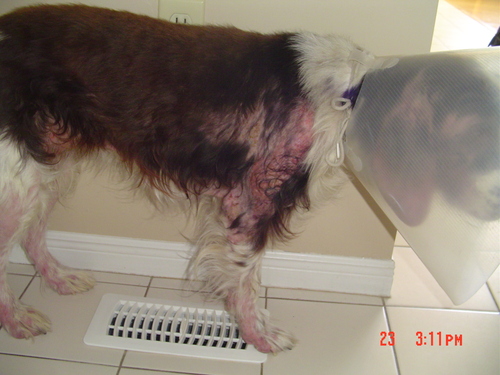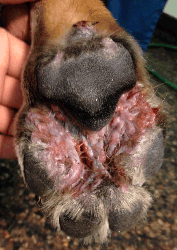What is Dog Mange? Dog Mange is an infestation of skin mites. There are two main types of Dog Mange, Sarcoptic and Demodeptic and are sometimes known as Scabies or Red Mange. Scabies or sarcoptic mange has Sarcoptes scabei mites that burrow into a dog’s skin and Demodectic mange has Demodex Canis mites which live in the hair follicles. While Demodeptic and Sarcoptic Mange are the more severe and most common types of mite infection, there is another lesser known Mange called Cheyletiellosis which is known as “walking dandruff” caused by Cheyletiella yasguri mites living on the surface of the skin.
Differing types of Mange
Identifying the different signs and types of mange is the first step in combating the condition. There are two main types of dog mange, demodex and sarcoptic, and each comes with its own set of challenges and solutions. The third, Cheyletiellosis can be far easier to deal with.
Also known as demodex or demodicosis, demodectic mange is caused by Demodex canis, a commonly occurring mite. These mites usually inhabit every dog, but problems begin when they overpopulate due to a weakened dog’s immune system that becomes unable to keep the mites in check.


Sarcoptic mange, on the other hand, is caused by Sarcoptes scabiei (microscopic spider-like mites). Also known as scabies, sarcoptic mange is extremely contagious between pets. It begins in one area of the dog’s body, and when left untreated, it can spread over the entire body.

Though demodex and sarcoptic are the more severe types of mites, there is another one that causes mange-like problems. Known as Cheyletiella yasguri mites, they cause Cheyletiellosis or “walking dandruff.”

Rarely does this condition cause the intense itching associated in common with the other two types of mange. Cheyletiellosis is generally easy to eradicate using topical, over-the-counter, flea treatments, see our page on Mange.
What Does Mange on a Dog Look Like
It can be very difficult to recognise the different types of mange on a dog, Cheyletiellosis of course looks like a bad case of dandruff.

Sarcoptic and Demodectic mange both look very similar in the early stages with small lesions of dry flaky skin that is reddish in color and hair that is falling out. The skin can be mottled red or pale white with red patches.


A Springer Spaniel with Sarcoptic Mange
Only in extreme cases do you get the large patches of scaly skin and this tends to be demodectic but may need a vet to confirm. In genearl once the infection has a hold the Demodectic Mange tends to look Angrier in that the lesions look harder, more scaly and the skin appears more inflamed and occassionaly swollen possibly with nodes in some areas.



Sarcoptic Mange in Dogs – Scabies
Sarcoptic Mange also known as Scabies is an infestation of skin mites (Sarcoptes scabiei) that burrow into a dog’s skin. Dogs of any breed and age can get mange or scabies. Typically, mites prefer feeding on areas that have relatively little hair. Prime spots include the abdomen, armpits, and elbows.

The ear margins are another common site that you might notice mange symptoms – especially if it’s a case of sarcoptic mites.
After burrowing under the dog’s skin, they mate, lay eggs, and die. The eggs hatch, become larvae, then mature into adults that plague your dog.
The whole process begins again unless treated. The adult mange mites are round-shaped, have four pairs of legs, and are 0.2–0.6 mm long. They are covered with tiny triangular spines. The female mites are almost twice as large as their male counterparts.
Dogs infected with mange mites become intensely itchy and restless. The mites can be easily passed on to other dogs and pets through indirect or direct contact.
There are many effective drugs, some from over the counter stores and some only available from the veterinarian. Anti-parasitic shampoos, dips and spot-on treatments are also available, but multiple treatments may be necessary taking up to six months to fully recover.
Scabies from dogs can cause their human owners similar skin problems and medical help should be sought.
Demodectic Mange in Dogs (Red Mange)
Demodectic Mange or Red Mange (demodicosis) is an inflammatory disease caused by the Demodex mite. The mites inhabit the hair follicles and skin of a dog and once there rapidly increase in number and thus the spread increases. It can lead to skin lesions, skin infections and hair loss.

Demodectic mange in dogs can be localized, which means it might only affect specific areas of the body such as tummy or armpits etc, or it can become generalized and spread to affect the entire body.
Localized symptoms are generally mild, with small lesions occurring in patches particularly on the face, torso and/or legs.
If the symptoms are generalized, there will be more widespread lesions across the body. These symptoms can include alopecia, a redness of the skin (erythema) and the appearance on the skin of scales and lesions.
Causes of Red Mange
The demodex mite is a normal inhabitant of your dog’s skin. In small numbers, these mites cause no symptoms or problems and may actually serve an important role as part of your dog’s normal skin.
There are three mite species that have been identified to cause mange in dogs. The species of mite most commonly associated with demodicosis is the Demodex canis, which inhabits the skin and hair follicles and is believed to be transferred from mother to new-born puppies during nursing.

This means that nearly all dogs carry these mites yet very few dogs suffer any symptoms.
The problem comes when dogs have a compromised immune system, the mites then start to multiply unchecked, which then leads to demodectic mange and itchy skin, giving a red colouration to the skin which is where it gets the name Red Mange.

Cheyletiellosis – “Walking Dandruff”
This is by far the easiest type of Mange to spot and also the easiest to treat. As the nickname “walking dandruff” suggests your dog will have a considerable amount of dandruff.
The most common area for this is the back from shoulder to tail, however it may be localised in small areas or it could be that the entire coat is covered in dandruff.

This dandruff is caused by the actions of the Cheyletiellosis mite living on the surface of the skin but also delving into the keratin level of your dog’s skin (the outer level of skin) and can cause flaking and or crusting which is known as dandruff.
Treatment for Walking Dandruff
The best method for treatment is to use a preventative course of flea prevention which will stave off any attack.
If you already have an infection then there are a numerous number of treatment available from any good pet store – if you want to see some our favourite products available online for this condition then go to our page on Mange Remedies here.
General Overview of Mange
Mange can be extremely uncomfortable for your dog and is potentially contagious for other animals within your home. In some cases it can also be transmissible to humans causing itchy bumps on your skin.

Your dog might develop sensitive sores, lose hair, be restless, and be in intense pain, causing much anxiety to you and your family. Your veterinarian can advise on appropriate mange medications and there are also many options available online or from your pet store.
Try to keep your other pets away from the dog with mange until treated and it’s safe to play together again.
If not treated, the condition may worsen, leading to scabbing and scaling of the skin. Besides the medications prescribed by your vet, several home remedies can help eliminate the condition.
From simple hygiene to diet and bathing to food additives, mange can be easily handled at home, making it easier for your pet and possibly cheaper for you. See our page on Mange Treatments.
To avoid the possibility of a repeat mange infestation, always remember to sanitize all the areas where your dog has visited. It’s also a good idea to wash their bedding or, if possible, replace their bed.
The Symptoms of Dog Mange?
Most of the mites prefer the parts of a dog’s skin with less hair, so typically the first places to look are the belly, armpits, and around and inside the ears. Symptoms of mange might not manifest for ten days to 8 weeks following infection.
Some dogs can also be asymptomatic carriers. So if your dog catches the condition, it could be quite challenging to figure out where he contracted it.
Putting Cheyletiellosis (walking dandruff) aside, both demodex and sarcoptic mange tend to present similar symptoms:
- Hair loss
- Red, irritated skin
- Scaly/scabby skin
- Sores from scratching
- Little bumps where the mites have burrowed
With more advanced cases of mange, you might also see:
- Weight loss
- Lethargy
- Reduced appetite
- Irritability
- Fatigue as the itchiness may stop the dog from sleeping well.
Many of the available over-the-counter products contain ingredients such as sulphur or tar which help to kill the mange mites so be certain to do your homework if you have any allergies to these products.
Unfortunately, most of the early symptoms of mange resemble those associated with allergies, making them difficult to diagnose which is why pre-emptive treatments are best.
How do you get rid of mange?
Mange is a skin disease caused by a parasite called mange mite. Mange causes severe itching, bald spots, and lesions in dogs. Fortunately, there are several ways to get rid of mange. Some dog mange solutions will require a visit to the veterinarian, although several are over-the-counter products. Also available are several home remedies worth trying.
This part of the article looks into what are some of the different types of treatment, and some of the popular home remedies. We also look at what you must avoid in your attempt at making your furry family member feel comfortable.
Home Remedies for Mange
The last thing anyone would want is to assume that their beloved dog has one type of illness when it’s something else. Severe mange cases, particularly sarcoptic mange, don’t get better without prescribed medication from a veterinarian. Your vet may recommend topical or oral treatments as shown in our page on Mange Treatments.
However, if you are in a situation where veterinary care is not accessible or readily available, you might consider trying some of the home remedies. The important thing is to always keep your dog’s health and well-being at the front of your mind. If such home remedies don’t work, be ready to visit the veterinarian.
Boosting the dog’s immunity and proper nutrition
Healthy dogs with good immunity are better placed to resist and fight parasitic infections. Mange can be prevented by keeping your dog’s immune system healthy with well-balanced and proper nutrition.
Consider adding dietary supplements that can help in relieving itching while boosting his immune system. Colostrum, probiotics, omega-3 fatty acids, and MCT oil are helpful products. Giving him extra vitamin C, D and A also help in boosting immunity.
Before you make any dietary changes for your pet, first consult with your veterinarian or a certified animal dietician. This ensures the dog is being fed on a well-rounded diet.
Can Humans get Dog Mange?
Yes, humans can easily pick up Scabies (Sarcoptic Mange) and they can also pick up ‘Cheyletiellosis or walking dandruff‘.
Most of the time, parasites and infectious diseases are relatively species-specific. For example, sarcoptic mites can only complete their full life cycles on dogs or other animals. However, you can still contract scabies from your dog. Consequently, you may suffer from itching and rashes.
Can Humans get Dog Mange? Not Demodex – Demodectic Mange is very rarely spread to humans, or for that matter other dogs.
Sarcoptic Mange – Scabies
With Scabies the mite can be passed from dogs to their unwitting owners by direct contact, or by contaminated grooming tools such as brushes, combs or clippers and also things like infected bedding, or even your couch if that’s where the dog sits.

If you suspect your dog has sarcoptic mange, keep him off shared furniture, avoid very close contact, especially with kids, and wash their bedding. Wash your hands after treating or touching pets who have mange to prevent infection.
Be aware that humans have their own version of scabies, but it’s not spread by animals such as dogs or cats, although the symptoms are also severe and require treatment.
If you suspect you have scabies, seek immediate medical treatment. The doctor will prescribe medications, “scabacides,” which kill both the mites and their eggs.
Cheyletiellosis – Walking Dandruff
This type of Mange is transferable to humans and normal dandruff shampoo for Cheyletiellosis is unlikely to work, special medicated shampoo from the chemist is likely to be needed.

Dogs can get the Cheyletiella yasguri mite from other warm blooded mammals such as cats, rabbits and other dogs. The mite is about one third of a millimetre long and once an infection is found it will horrify many.
What you tend to see is dandruff on your dogs coat, but what you are actually seeing is lots of the mites moving around giving rise to the nickname walking dandruff, because you can actually see it move.
Conclusion about Mange
Mange is contagious and can be quite severe on pets. If you suspect your dog has the condition, schedule a vet appointment to get a professional diagnosis.
Here at Top Lap Dogs we advise you to consult a veterinarian because even a mild case of mange can snowball.
Decontaminate your home to avoid re-infestation.
If you just can’t get to the vet then take a look at our page on How to treat dog mange at home.




